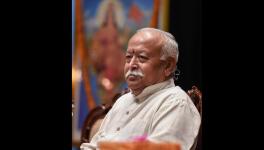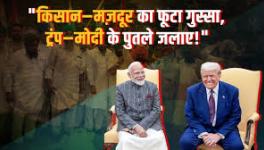Gujarat Elections: AAP in Electoral Discourse, But Thy Vs My Hindutva May Not Work
Image Courtesy: @AAPGujarat
Ahmedabad: For the first time since 1995, Gujarat is witnessing a three-cornered contest in the Assembly elections, with the ruling Bharatiya Janata Party (BJP) seemingly better placed than Congress or the debutant Aam Aadmi Party (AAP). This is a major shift from the two-party dominance over the state’s politics.
Former chief ministers and stalwart leaders, such as Chimabhai Patel, Shankersinh Vaghela and Keshubhai Patel, in the past attempted to disrupt the bipolar polity, but failed miserably.
Though Union Home Minister Amit Shah and BJP’s state president CR Patil have claimed that their contest is once again with the Congress this time, the ground reality suggests otherwise. Of late, AAP has emerged as a key player in the political discourse in the state — with several voters seeing it as an alternative to BJP and Congress.
So, how would the Delhi Chief Minister Arvind Kejriwal-led party fare and how much would it damage the prospects of the two parties? Would it be able to translate its support, especially in urban Gujarat, into seats?
Based on conversations with voters in the south, central and north Gujarat, one arrives at the conclusion that the new political entrant enjoys an unblemished image of fulfilling many promises in Delhi and Punjab, where the party surprised many by bagging 92 seats in the 117-member Assembly.
In the 2015 municipal corporation elections in Gujarat also, AAP won 27 seats in the diamond city of Surat (a traditional BJP stronghold) but faced a humiliating defeat by securing just 0.1% votes in the 2017 elections— which it had contested from 30 Assembly segments.

One takeaway of discussions with a range of voters on the ground is that replacing BJP and Congress and pulling off a surprise will not be so easy for AAP in Gujarat, where the variables and dynamics of politics are completely different from other states. Every constituency here a set of issues that impact the outcome.
AAP’s influence in Gujarat is concentrated in the urban pockets of Surat, Ahmedabad and Gandhinagar only. It seems to be stronger in Surat where it is engaging BJP in a tough (in fact, extremely tough) battle at least in five Patidar-dominated constituencies — Varachha, Kamrej, Katargam, Karanj and Olpad.
Angry with BJP for allegedly destroying their businesses, the youth of the Patidar community (once a staunch voter base of the ruling party) — which is politically influential, economically sound (with their dominance on the textile and diamond industries) and numerically stronger (around 18% of the total population of the state) — are rallying behind AAP. However, community old-timers still seem to be with BJP.
Prominent AAP leaders are activists of the Patidar Anamat Andolan Samiti (PAAS), which spearheaded the reservation agitation between 2015-17.
All prominent AAP leaders belonging to the Patidar community are fighting from the five seats mentioned above, except Isudan Gadhvi who is the party’s chief ministerial candidate.
All 12 seats of Surat are at present held by BJP. Apart from AAP, Congress too may snatch a seat (Surat East) from the saffron party. Congress’ Aslam Cyclewala, secretary of the Gujarat Pradesh Congress Committee and former councillor of the Surat Municipal Corporation, is taking on BJP’s Kanchan Jariwala from the Muslim-majority seat where the minority community forms over 90% of the total electorate.
The AAP’s ambition to penetrate into south Gujarat’s tribal belt does not seem to be working as Congress seems to be stronger there because of its “active” participation in a series of agitations against the Par, Tapi, Narmada river linking and other so-called development projects in the region. The party’s alliance with Bharatiya Tribal Party (BTP) also fell through.
Though AAP has a fierce and aggressive social media campaign, its mobilisation and campaign strategies have largely ignored the interests of dalits, Other Backward Classes (OBCs) and minorities. The party does not have any presence among trade unions, students’ bodies, agricultural marketing committees or milk cooperatives. These are dominated by the cadres of the Rashtriya Swayamsevak Sangh (RSS) and its political wing — the BJP.
The party is faced with other challenges as well: minimal organisational structure and network of workers on the ground to campaign and bring its voters to the polling booth.
In nutshell, AAP will dent the prospects of BJP and Congress in the rest 182 seats, with the grand old party likely to be a bigger loser than the saffron party. This is indicative of the fact that the state is witnessing a triangular contest in this election.
It would be interesting to note how AAP fares (the role it plays in splitting votes) in 57 seats where victory margins were thin (less than 5%) in the previous election. While the Congress had won 30 such seats, the BJP managed to get 25 seats.
BJP’s Raut Madhubhai Bapubhai had defeated Congress’ Chaudhari Harjibhai from the Kaprada constituency in the Valsad district by just 170 votes (the thinnest margin in the state). Godhra was the seat where BJP’s CK Raulji had beaten the Congress candidate by 258 votes (0.14%).
In 29 such seats, candidates had won by a margin of less than 2%. Out of these seats, 35 were won with a margin of fewer than 5,000 votes.
HINDUTVA HEGEMONY
However, there is one factor that defines political common sense and influences the voting pattern across the state — Hindutva.
The CSDS-Lokniti survey ahead of this year’s election in the state finds that two-thirds of the Gujaratis are “satisfied” with the performance of the saffron party — which has been ruling the state for the past 27 years in a row.
This is despite the fact that businesses in the state, which is a hub of industries such as textile, diamond, fertilisers and chemicals, pharmaceuticals, etc., are worst hit by high inflation and Goods and Services Tax (GST).
In spite of the economic woes, the ‘’satisfaction with the BJP’s performance in the state points out that it is Hindutva (as a form) that sets the electoral discourse here. And, therefore, AAP had to come up with a novel suggestion during the Diwali festival that Indian currency notes should have Laxmi and Ganesha images printed on them.
Kejriwal echoed BJP leader Subramanian Swamy who had said the same back in 2020. With this statement, AAP visibly took a plunge into Hindutva.
This stunt was in addition to AAP’s promise of free pilgrimage to Ayodhya. Interestingly, as the party was labelled a Muslim appeaser, Kejriwal said he was born on Krishna Janmashtami and sent by god to save the people of Gujarat from the “children of Kansa”.
Both AAP and BJP, are in a way offering people two slightly different tastes of Hindutva to win their support. The electorate, especially in urban pockets, reveal, (if they are taken into confidence) that their acceptance of BJP is just because it has shown Muslims their place.
“Despite all misses, the BJP hit what nobody could do over the years. Its ideology is clear. The party does not field others except us to liberate it from their votes,” they say.
Prime Minister Narendra Modi enjoys massive support among voters as a champion of Hindutva. Therefore, AAP’s promises to give unemployment allowance, free electricity, improved health infrastructure, government jobs, free tours to pilgrimage places, monthly stipends to all women and minimum support price for fish etc., are not likely to woo voters — a large section whom are apparently willing to forgo these for the Hindu cause
Get the latest reports & analysis with people's perspective on Protests, movements & deep analytical videos, discussions of the current affairs in your Telegram app. Subscribe to NewsClick's Telegram channel & get Real-Time updates on stories, as they get published on our website.
























